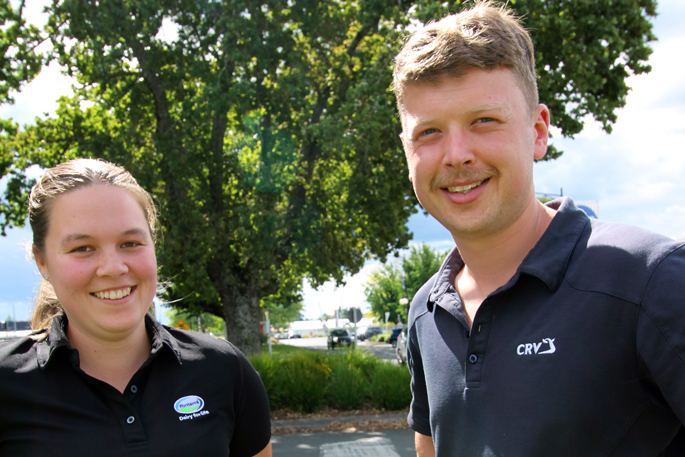An Englishman, an Irishman and a Welshman walk into a pub.
No, this is not a joke, but a typical Piarere Young Farmers Club meeting.
The thriving Waikato club has a cosmopolitan membership, a 50/50 male/female ratio, and many non-farmers.
Club chairman Mark Whelan and vice-chair Abbey Thompson laugh that the secret of success is “don’t talk farming”.
Piarere YFC has a footprint stretching from Waharoa to Putaruru, and Piarere to the Kaimai Range.
And yes, club meetings are held at a pub – the Okoroire Hotel. There is a monthly business meeting, where items such as events and fundraising are discussed, and a Monday catch-up over a beer.
YFC caters for those aged 16-31, with the Piarere club boasting about 50 members.
“And some wouldn’t know what a cow looks like,” says Mark.
Membership spans the “agri-community”, with Piarere YFC including a teacher, a butcher and a racing greyhound owner.
Mark Whelan is a sales consultant for dairy herd improvement specialist CRV, while Abbey Thompson is a Sustainable Dairy Associate with Farm Source.
Along with a strong UK influence in the membership – Mark is originally from Ireland – the United States and South Africa are also represented at Piarere YFC.
“It brings people together,” says Abbey and Mark.
Mark joined Hamilton-based CRV in 2021 after a stint in the South Island.
“I pretty much knew no-one when I came here,” he says while speaking to Coast & Country News in Matamata. “A friend told me to come along (to Piarere Young Farmers Club).”
Mark says he immediately found that he was talking to like-minded people at the club.
He became vice-chairman in 2022 and was elected chair at the club’s annual meeting in November.
Abbey Thompson is a Matamata “local”, growing up on a family farm.
She joined Young Farmers when studying at Massey University and linked up with the Piarere club in 2021 after returning to Matamata the previous year.
Paintball was a club activity at the time, which got her “hooked”.
The following year she became Piarere YFC treasurer, assuming the vice-chair role also at the October changeover.
Abbey and Mark say the club’s major annual fundraiser is covering silage stacks and picking up hay.
“It helps farmers and is the club’s main source of income.”
A non-profit organisation, the club ploughs the money back into activities for members including ten-pin bowling and of course paintball, Piarere YFC tee-shirts.
There are also Waikato/Bay of Plenty YFC interclub events such as netball and dodgeball, along with a composite stock judging/clay bird shooting/fencing competition.
Go-karting is similarly enjoyed with neighbouring clubs.
Adding to the funds, Piarere club members pitch in with their Waikato colleagues in covering a giant silage stack annually at Gordonton.
The most high-profile event on the calendar is the annual Young Farmer of the Year contest, which started in 1969.
For the Piarere club, the path to potential national glory starts with the regional final in Ngatea in April.
Abbey is on the organising committee for this event, while Mark is competing.
The seven regional finalists go on to the coveted national final, hosted in Hamilton for three days in July next year.
Among the past winners is current Waikato MP Tim van de Molen, who claimed the national title in 2013.
Mark and Abbey say Piarere YFC has links to ag-based organsiations such as the Rural Support Trust, DairyNZ, Dairy Women’s Network and Beef + Lamb New Zealand.
The club also regularly engages speakers on a variety of topics including legal matters and industry training.
Club membership has doubled in the last 18 months, which they put down to “the fun stuff” at the heart of Piarere YFC activities.
“We keep it pretty light-hearted.”
YFC FACTS
New Zealand’s first Young Farmers’ clubs were established in Feilding and Auckland (1927)
By 1937 there were 118 clubs across the country.
Many went into recess during World War Two, but by 1948 the number had reached 306.
Also in the late-1940s, a partnership organisation – the Country Girls’ network - was formed.
In 1972 the two groups combined to become the Federation of Rural Youth.
A year later it became the New Zealand Federation of Young Farmers Clubs and in 2003 it changed again to New Zealand Young Farmers.
At present there are more than 1700 members in 63 clubs around New Zealand.
The nationwide organisation now also includes a TeenAg membership for secondary school students and an NZYF Alumni Network for former members over the age of 31.
The Alumni Network was launched in 2022 as a way for NZYF members to still stay connected with the organisation.
Network members are able to retain a link via mentoring/advising clubs if they need support; by making donations to the organisation; or sharing opportunities with current NZYF members such as internships or jobs associated with the rural sector.



0 Comments
Leave a Comment